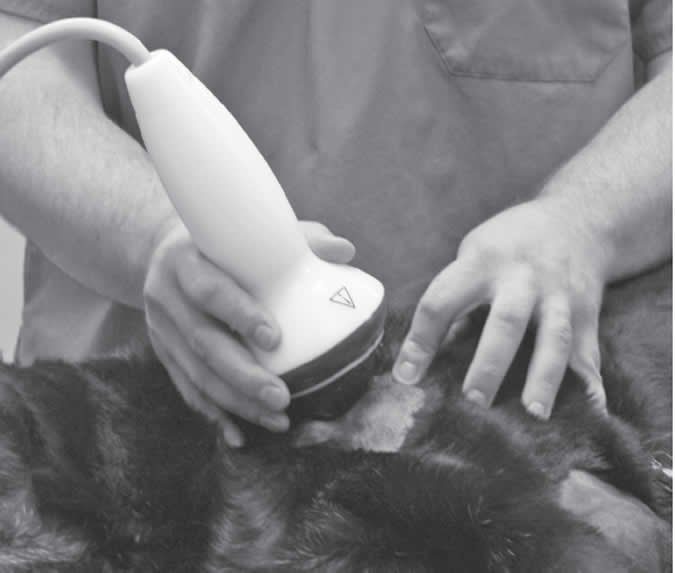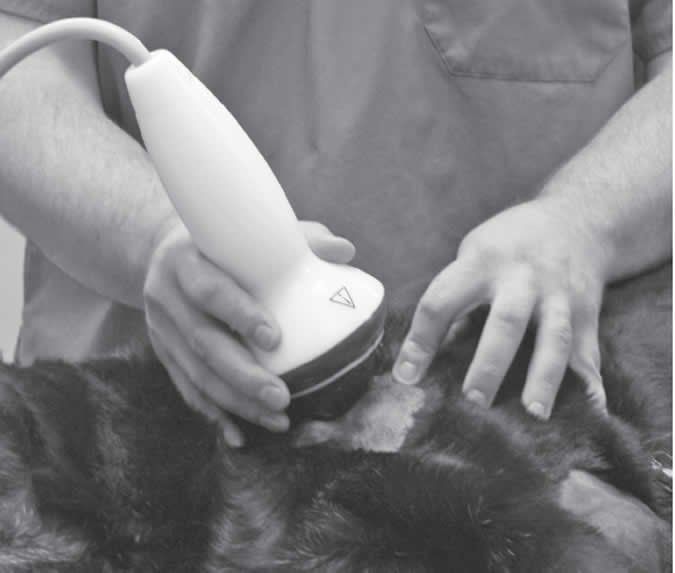Pulsevet

You’ve no doubt heard the term “rotator cuff.” It applies to dogs as well as people and refers to the fact that the shoulder joint is supported by a cuff of muscles. If those muscles are torn, stretched, or otherwise compromised, moving the shoulder can cause great pain. And fixing the problem requires patience. In a person, for example, wearing a sling might be required for weeks to months, especially if there has been surgery to repair the injured muscle. The patient may not even be allowed to lift a glass of water because the muscle tissue, still weak, can tear all over again.
Try telling that to a dog, especially an active retriever or shepherd or other large-breed dog — the type most prone to develop shoulder lameness, which shows itself in the form of a limp in a front leg. “A dog can’t be in a non weight-bearing sling for months on end,” says Tufts veterinary orthopedist Michael Kowaleski, DVM, DACVS/ECVS. “You can’t do months of ‘restricted activity’ very easily with a dog who’s used to jumping off the back deck every day.
“Shoulder lameness in middle-aged and older large-breed dogs is pretty common,” Dr. Kowaleski adds. “It’s an injury of wear and tear. You play tennis long enough, you will likely tear your rotator cuff. You do dog things long enough — landing on your front legs jumping down the steps, and so on — and the shoulder cuff can eventually get torn that way, too.”
Because such shoulder problems are relatively common in dogs and because they can’t cooperate in healing from an operation to fix them, Dr. Kowaleski and his Tufts colleagues started looking for ways to fix their rotator cuff injuries without surgery and without a long period of delicate recuperation. They appear to have found one: extracorporeal shockwave therapy, “extracorporeal” signifying “outside the body.” That’s right. By aiming shockwaves at a dog’s shoulder, veterinarians are finding that they can heal it.
“At Tufts, we use it a lot in dogs,” Dr. Kowaleski says. “If we have a dog with a shoulder problem, that’s now our first line of treatment. By the time a dog gets to us, she usually has been limping for months, putting as little weight as possible on the affected leg. She’s already been rested, she’s already been given pain relievers, and they haven’t worked. So we often end up using the extracorporeal shockwave therapy.”
For joint problems in other parts of the body, Dr. Kowaleski explains, veterinarians frequently resort to a surgery. That’s because in a lot of cases, what’s causing the pain in the area of a joint is not a tear in muscle but a tear in one of the ligaments that normally stabilizes the joint. The tear makes the joint too loose and leads to the resultant pain. In a surgery, you can often stabilize the joint by cutting the bone in the area in such a way as to change the forces in the joint so that the ligament is no longer needed. The dog is back on her feet the next day; complete healing takes just a few months.
But because the shoulder joint is unique, with only muscle, there’s no ligament around which a surgeon can do an end run. It’s the one area of the body where instead of ligament, it’s that special cuff of muscle that stabilizes the joint. And it’s a tear in the muscle that causes the joint to be too loose and create pain. “It’s a different mechanism of ‘too loose,'” Dr. Kowaleski says. Thus, you have to work to repair the muscle itself, which is what makes the situation so delicate, and what makes any surgery so difficult to recover from. The muscle can tear again all too easily. But Dr. Kowaleski has found that the shockwave therapy “is what a lame shoulder needs. It jumpstarts healing.”
How does extracorporeal shockwave therapy work?
Think of a machine that’s sort of like an ultrasound machine. “There’s a big white box that’s the brains of the machine,” says Dr. Kowaleski, and then “a cord with a hand piece” that’s reminiscent of an ultrasound machine’s probe. In this case, the machine “has a conical tip on it — silicone-filled rubber — so it’s kind of squishy,” he comments. The doctor moves the tip along the dog’s shoulder, aiming the shockwave approximately to where x-rays, ultrasound, and/or arthroscopy have revealed damaged areas deep within the muscle tissue. The shock, coming from outside, penetrates the dog’s body by two inches.
To understand how the shockwave works, Dr. Kowaleski makes the comparison of putting a loudspeaker next to a glass. “The glass vibrates and can shatter,” he says. “That’s basically the mechanism by which muscle tissue is healed.” That is, the shockwaves create vibrations in the muscle tissue. In a dog’s shoulder, the vibrations cause cells to release growth factors. These factors stimulate growth of fibrous tissue, which in turn, helps to tighten the muscle tissue in the area via scarring, and that provides more stability for the joint.
That is not the only positive effect, however. The shockwaves are also believed to help by breaking up mineral deposits in the damaged rotator cuff that add to the pain. Secondary to muscle instability, Dr. Kowaleski explains, calcium deposits can develop in the muscle tissue. When the muscle tears, blood clots fill in the torn area, and the clot can turn to calcification, or mineralization. That hardness in an area where it’s not supposed to be can increase pain. But the shock breaks the mineral deposits into multiple pieces. “A big piece can be causing pain,” says Dr. Kowaleski, “but if you break it into little pieces, it doesn’t hurt as much. Sometimes the body can even resorb little pieces, but not big ones,” he adds.
It’s similar to the breaking up of stones in the bladder or kidney through shockwaves, Dr. Kowaleski says. “A pressure wave goes through your body and breaks the stone into little pieces so it can come out. It’s a different machine, but the same technology.”
There are other benefits of extracorporeal shockwave therapy for a lame shoulder, too. It has been shown to stimulate the creation of new blood vessels in a process called neovascularization. The shockwaves cause the release of cytokines, proteins released from certain cells that are necessary for blood vessels to form. The extra blood vessels help carry nourishment in the form of oxygen and other elements to the damaged muscle to allow it to heal better.
Shockwaves also have anti-inflammatory effects and encourage collagen to form in the afflicted area, which helps build compromised muscle back up. In fact, because normal collagen structure is affected immediately after treatment, Dr. Kowaleski advises that dogs getting the therapy should have exercise restriction immediately afterwards: walks on leash. It takes time for the newly configured collagen to get up to speed, so to speak.
Shockwave therapy even has an analgesic, or pain-relieving, benefit. In fact, says Dr. Kowaleski, some veterinarians use it for elbow, hip, or knee arthritis in dogs. You can get some significant pain relief for a few weeks or even months. But with the shoulder, extracorporeal shockwave therapy — we call it ESWT — can actually heal it. Most dogs are still good long after the analgesic affect has worn off.”
The proof is in the research
Dr. Kowaleski helped prove ESWT heals damaged rotator cuffs in a study he conducted with Tufts colleagues that looked at 15 dogs they had treated for shoulder lameness — one of the first research studies to examine the effect of the treatment systematically. All the dogs had previously failed to improve with conservative management — exercise restriction and pain relievers (some of them quite strong) and had already been walking with a limp for quite a while. Each dog — Australian shepherds, Labrador retrievers, and several others, all with an average age of about six years — was given three ESWT treatments, with three to four weeks between each treatment.
Nine of the dogs then returned to the hospital at Tufts for a final examination about a month after the final shockwave treatment. The result, reported in the Journal of the American Animal Hospital Association: lameness was improved in six of them, and gait was absolutely normal in the other three. More encouraging still: when 11 of the 15 dogs’ owners participated in phone interviews much later, in some cases many years, seven considered their pets to be in better shape, if not out-and-out normal in their gait.
The researchers were not able to tease apart whether the therapy worked because it made the muscles tighter (and therefore kept the joint in place better) or because it healed tissue or because of some combination of effects. Different dogs injure their shoulders in different ways. The important point is that it helped a variety of pets with a variety of shoulder joint/muscle disorders. The array of effects that lead to a positive outcome is in keeping with findings of benefit in research with people. Extracorporeal shockwave therapy is being applied in more and more situations, including intractable cases of tennis elbow and plantar fasciitis.
No wonder Dr. Kowaleski says ESWT is also “on the upswing” as a treatment for dogs. “It’s a burgeoning trend,” he comments. “It does fit for the particular problem of shoulder lameness, which is very difficult to treat,” he says. But he also envisions that veterinarians will keep finding “new ways to apply the technology” for pets in intractable pain.





